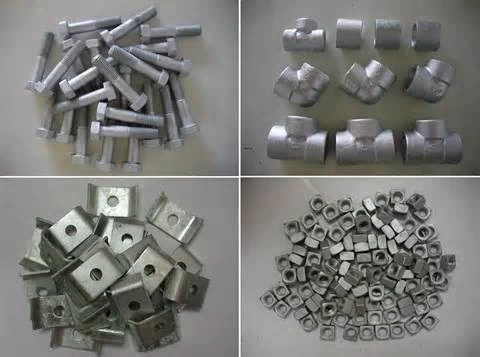Hot-dip galvanization
Jack Zou
www.diecastingpartsupplier.com
2014-12-26 14:32:08
Hot-dip galvanization is a form of galvanization. It is the process of coating iron, steel or
aluminium with a layer of zinc by immersing the metal in a bath of molten zinc at a temperature
of around 860 °F (460 °C). When exposed to the atmosphere, the pure zinc (Zn) reacts with
oxygen (O2) to form zinc oxide (ZnO), which further reacts with carbon dioxide (CO2) to form zinc
carbonate (ZnCO3), a usually dull grey, fairly strong material that stops further corrosion in
many circumstances, protecting the steel below from the elements. Galvanized steel is widely used
in applications where corrosion resistance is needed without the cost of stainless steel, and can
be identified by the crystallization patterning on the surface (often called a "spangle").[1]
Galvanized steel can be welded; however, one must exercise caution around the resulting toxic
zinc fumes. Galvanized steel is suitable for high-temperature applications of up to 392 °F (200
°C). The use of galvanized steel at temperatures above this will result in peeling of the zinc
at the inter metallic layer. Electrogalvanized sheet steel is often used in automotive
manufacturing to enhance the corrosion performance of exterior body panels; this is, however, a
completely different process which tends to achieve lower coating thicknesses of zinc.
Like all other corrosion protection systems, galvanizing protects steel by acting as a barrier
between steel and the atmosphere. However zinc is a more electronegative metal in comparison to
steel, this is a unique characteristic for galvanizing which means that when a galvanized coating
is damaged and steel is exposed to the atmosphere, zinc can continue to protect steel through
galvanic corrosion (often within an annulus of 5 mm above which electron transfer rate
decreases).

aluminium with a layer of zinc by immersing the metal in a bath of molten zinc at a temperature
of around 860 °F (460 °C). When exposed to the atmosphere, the pure zinc (Zn) reacts with
oxygen (O2) to form zinc oxide (ZnO), which further reacts with carbon dioxide (CO2) to form zinc
carbonate (ZnCO3), a usually dull grey, fairly strong material that stops further corrosion in
many circumstances, protecting the steel below from the elements. Galvanized steel is widely used
in applications where corrosion resistance is needed without the cost of stainless steel, and can
be identified by the crystallization patterning on the surface (often called a "spangle").[1]
Galvanized steel can be welded; however, one must exercise caution around the resulting toxic
zinc fumes. Galvanized steel is suitable for high-temperature applications of up to 392 °F (200
°C). The use of galvanized steel at temperatures above this will result in peeling of the zinc
at the inter metallic layer. Electrogalvanized sheet steel is often used in automotive
manufacturing to enhance the corrosion performance of exterior body panels; this is, however, a
completely different process which tends to achieve lower coating thicknesses of zinc.
Like all other corrosion protection systems, galvanizing protects steel by acting as a barrier
between steel and the atmosphere. However zinc is a more electronegative metal in comparison to
steel, this is a unique characteristic for galvanizing which means that when a galvanized coating
is damaged and steel is exposed to the atmosphere, zinc can continue to protect steel through
galvanic corrosion (often within an annulus of 5 mm above which electron transfer rate
decreases).




















